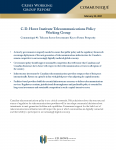Recognizing investment in Canadian networks
The public interest for telecommunications is multi-dimensional. Although some lobbyists seem to focus solely on lower prices, government policy needs to balance other factors, like investment in increased coverage, new technology and services, and quality.
Last Thursday, when Minister François-Philippe Champagne announced a new policy direction, there were 3 “associated links” in the press release:
- Order Issuing a Direction to the CRTC on a Renewed Approach to Telecommunications Policy
- Backgrounder: Summary of the Government of Canada’s new proposed policy direction to the CRTC
- Backgrounder: Renewing Canada’s approach to Telecommunications Policy: Context for Action
Much of the focus of media coverage was on the proposed Policy Direction as well as the disposition of the wholesale rates appeal:
We recognize the important balance that must be achieved between the need to invest in our networks and the need to promote continued competition and affordability. The wholesale rates decision made by the CRTC in 2021 is an attempt to correct errors made in 2019, and it makes permanent the rates that have been in force since 2016. The decision provides stability, and the government has determined that it will not alter this decision.
My initial impressions were captured in a blog post, “A new direction for Canadian telecom”.
I noticed that many of the news articles cited language that appeared in the Policy Direction Backgrounder, as opposed to the more moderate language found in the actual draft Order.
There seemed to be less attention on the Context Backgrounder, and as has become usual, that is where I like to focus.
I have talked about a theme of balance that I think continues from Minister Navdeep Bains era 5 years ago, balancing Quality, Coverage And Affordable Prices. A few weeks ago, I observed, “In its rejection of an appeal on the CRTC’s Review of Wireless Services, just last month Cabinet said: “the Governor in Council considers that the Commission’s decision appropriately balances investment incentives to build and upgrade networks, and sustainable competition and the availability of affordable mobile wireless prices for consumers”.”
Nearly two years ago, Minister Bains said Canada’s Future Depends on Connectivity. Generally, last week’s telecom policy announcement promises a framework that continues to balance consumer interests, including the incentives for service providers to make investments that deliver quality services, available to all Canadians.
Policy consistency is important. The context backgrounder leads with details of how these policies have delivered benefits for Canadian consumers:
Canada has benefited from very high investment levels over time, with the private sector investing $11.4 billion in 2020. Canada has consistently been above the Organisation for Economic Co-operation and Development (OECD) average. For example, in Canada the share of telecommunications revenues invested in capital expenditures over time was 30-50% above the OECD average. This has led to high quality telecommunications networks. For example, according to Ookla’s March 2022 Global SpeedTest, Canada ranked 16th out of 142 countries for median mobile speeds, ahead of all members of the G7, and 17th out of 182 countries for median fixed broadband speeds ahead of all members of the G7, except the USA and Japan.
When it comes to the household availability of full fibre networks, in 2020 the household coverage in Canada (49%) was ahead of the US (42%), Australia (16%), UK (18%), Germany (11%), and Italy (34%) and the EU average of 43%. Similarly, when factoring in cable networks, coverage of the faster speeds of 100 Mbps and 1 Gbps are available to 87% and 76% of homes compared to 76% and 51% in European Union countries. Data from OpenSignal shows strong speeds for new Fifth generation (5G) services with Canada ranking 4th in 2021, strong historical coverage of 4G services, and for more specialized application metrics Canadian operators were not among global leaders but above the sample average. Fibre and new 5G services continue to roll out and ongoing investments will ensure Canadians benefit from these and future technologies as they are introduced and deployed.
The subsequent paragraphs, talking about rural service gaps, demonstrate an understanding and appreciation of the challenging aspects of business cases to build in parts of Canada.
The background document provides a market overview and helps to understand the context in which policies are being formed, “promoting more competition, universal access and a more consumer-oriented telecommunications sector in Canada.”
Minister Champagne said “We recognize the important balance that must be achieved between the need to invest in our networks and the need to promote continued competition and affordability.”
This reference to balance, coupled with the Policy Direction’s requirement for predictability, provide important messages of policy consistency.
Have we seen the end of Calvinball in Canadian telecom regulation?

